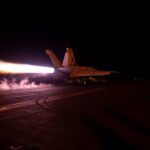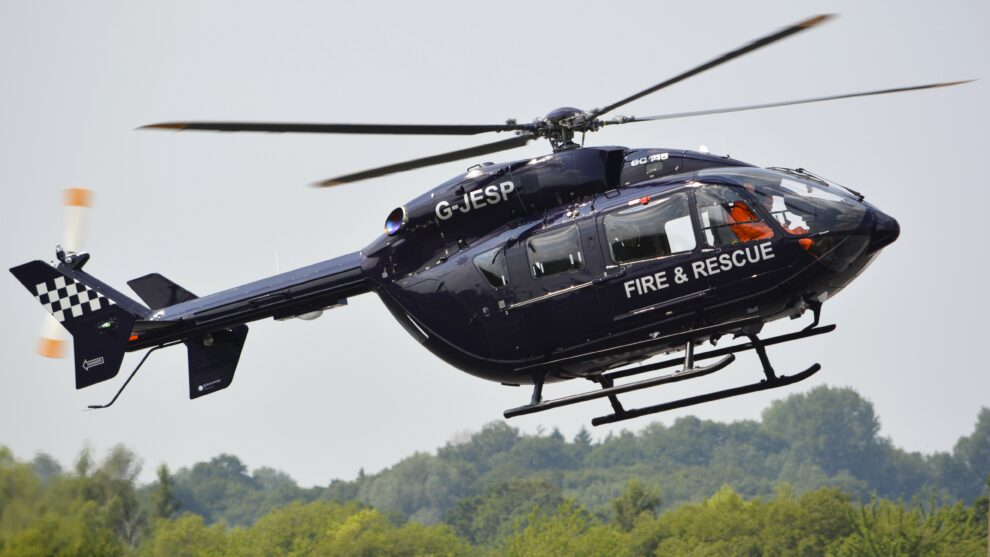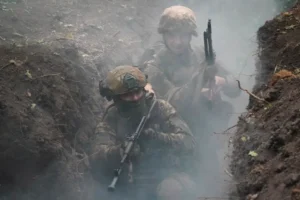In the last decade, the United Kingdom has seen an increase in large-scale fires, predominantly in the Summer, ranging from fires in fields to moorlands and occasionally woodland areas. Some of the reasons are natural causes, as well as the usual careless individuals and arson. During July 2022, the country experienced the hottest weather on record, where temperatures reached 40 degrees Celsius (104 degrees Fahrenheit), and, as such, some areas received a red warning for extreme heat.
The BK Experiment
In May 1995, the London Fire Brigade (LFB) experimented with a sole Messerschmitt Bolkow Blohm (MBB) Kawasaki BK117C1 twin-engine helicopter for observation (using an optical system) and aerial transportation of fire crews. The aircraft was leased by McAlpines (now known as Airbus Helicopters Ltd) and was only on trial and progressed no further. A decade and a half later, in the southwest of the United Kingdom, the Avon & Somerset Fire Brigade had a Eurocopter EC145 for a trial, with the intent to carry a team of firefighters and their equipment to the likes of vehicular accidents, as a quick response unit. Again, it did not progress beyond a trial.
In 2013, Eurocopter trialed a purple EC145A (G-JESP) painted with the Fire Brigade logo around the United Kingdom, participating that Summer in a multi-agency demonstration during the annual Royal International Air Tattoo (RIAT), held at Royal Air Force (RAF) Fairford (United States Air Forces in Europe – Africa bomber base), west of London. The demonstration was called Airborne Angels, including a former police Air Support Unit (ASU) Eurocopter EC135T2 and a new Devon Air Ambulance Trust (DAAT) EC135T2. The same airframe was exhibited at the bi-annual Helitech exhibition at the London Excel later in the Autumn. In the last decade, no helicopters have been assigned to any of the Fire Brigades in the United Kingdom.
Managing Director of Airbus Helicopters in the UK, Lenny Brown, said: “We’ve put extensive effort into this sector in the UK in the past, and we still believe that helicopters have an important contribution to the nation’s national resilience infrastructure. As the threats and risks we confront become more complex and sophisticated, there is a growing requirement for specialized emergency response agencies to be urgently deployed with their equipment, frequently over long distances and to remote locations. We believe that helicopters such as the H145 and H135, already the global workhorses of the law enforcement and EMS communities, provide the optimum solution to meet the operational units’ needs. We look forward to engaging with the appropriate authorities to explain our capabilities.”
“Additionally, we are seeking to support the UK military in using its existing fleets of H135 Juno, H145 Jupiter and Puma helicopters for conventional firefighting operations as the incidence of wildfires grows year by year, driven by climate change. Over the last decade, this issue has grown in the UK from being almost non-existent to becoming a major demand on the nation’s firefighters with increasing threats to life and property. Although RAF Pumas have sporadically been deployed in emergencies, all of these helicopters can carry external water loads, and all crews are trained in external load carriage with minimal additional training and modification needed to fulfill the role. We’re clear that our helicopters offer an elegant, low-cost solution to provide resilience against this growing problem.”
Bambi to the Rescue
The exceptionally hot Summer of 2018 caused fires to break out across several areas of the United Kingdom. Scottish helicopter operator Skyhook Helicopters in Fife used their Airbus AS350B3 Squirrel helicopters to aid the local fire brigade in combating a hill fire on the 33000-acre Attadale country estate in Strathcarron, in the Highlands, in the North-West of Scotland.
A month later, in July, a large fire broke out on Saddleworth Moors on the outskirts of Manchester. In response, there were over twenty fire trucks from the local Lancashire County Fire Brigade service, but crews attended from as far afield as Tyne & Wear on the opposite side of the country. There was a white 1979 Bell 205A-1 (N35EH), belonging to Heli-Lift, that was on a contract in the area for underslung load/ long line work, that assisted with firefighting as well as Scottish helicopter operator PDG Helicopters, with their Airbus Helicopters AS350B2 (G-PDGB), using their Bambi buckets to extract water from the nearby Dove Stone Reservoir.
Two years later, the Heli-Lift white Bell 205A-1 again assisted the Fire Brigade, this time in combating fire on Hatfield Moors in North Lincolnshire. The aircraft scooped water from the River Torne and local lakes to fight the fire. Heli-Lift has been involved in supporting firefighting efforts since April 2011, when they were first called in to assist fire crews after a blaze spread on Marsden Moor, West Yorkshire, this one caused by a quad bike that had caught on fire. They also operate a 1977 Bell 212 in their fleet.
According to Stuart Ring, director of Heli-Lift Services Ltd, their fleet types are the largest in the United Kingdom to fight fires, despite their size, and says there are two bases in Yorkshire and Derbyshire, where the helicopters are forward-located. He believes that problems lie with a lack of funding within the emergency services and a general lack of understanding about using helicopters within the fire brigades. In his opinion, the field fire in Wennington, Essex, during July 2022, which spread to several houses, could have been contained if the Essex Fire Brigade had called for aerial support, as there is a nearby reservoir (north of the village) which could have been used for picking up water using a Bambi bucket. He also explained how the complexities of intervening in a fire on land in England and Scotland further complicate direct action. The Forestry Commission and the separate Forestry and Land Scotland (FLS) manage Scottish national parks and forests. As such, it is easier to deal with them if there is a fire on land, whereas in the United Kingdom, a lot of ground is private.
Devon-based AH Helicopters Ltd has used their single-engine legacy MD Helicopters MD 500D and Airbus Helicopters AS350B3 Squirrel equipped with a Bambi bucket to combat the moorland fires on Dartmouth National Park in the very South West of the UK. They have also been asked to fly north to fight fires on Saddleworth Moor. According to Andrew Harvey, Chief Pilot, in his experience, the biggest problem comes with the reluctance (and at times embarrassment) of the fire brigade to utilize the helicopter as a firefighting tool, even when offered, and in one particular incident, it those who are in charge of the land themselves who are reticent and refusing airborne fire firefighting support. He cites the case where an area of the Brecon Beacons National Park (in Wales) was on fire for quite some time in the day. He had called the person in charge of the park that night to offer support only to be turned away with the surprising attitude of ‘let the area burn,’ as the person responsible was off duty for the weekend and didn’t wish to be disturbed.
With regard to the 2019 Saddleworth Moor fire, Andrew described “13.5 hours flying in MD500, dropping 450 liters of water every 2.5 minutes” over the ten days he dropped some 400,000 liters. Last year, in July 2022, the village of Wennington, Essex, to the north of Greater London, was all but destroyed when the heatwave caused a fire in a field, quickly spreading over the residents’ back gardens and engulfing buildings. Fire crews from more than seven different stations in the Greater London Fire Brigade attended the scene, as well as crews from the local area and further afield. This was not the only fire on that day, and fire services were severely stretched. Such a response may not have been needed if aerial support had been available. All the above are examples of incidents that have occurred in under a decade and a half in the United Kingdom, increasing in frequency and demonstrating the need for a dedicated aerial firefighting response.
The Military Option
The Royal Air Force (RAF) heavy and medium lift fleets, comprising the Boeing twin-rotor Chinook and Airbus Helicopters Puma, can perform aerial firefighting and assist the civilian authorities if need be. During the 2018 Saddleworth Moor fire, there was the option to call in the Chinooks with a Bambi bucket to extract water from local lakes, reservoirs and rivers, but it was not used. The likes of the Chinook and Puma belong under the tri-service Joint Helicopter Command (JHC), as all battlefield helicopters from the Royal Air Force (RAF), British Army Air Corps (AAC), and Royal Navy Fleet Air Arm (FAA)/ Commando Helicopter Force (CHF), fall under this.
Fight Fire with Fire
Conservation strategies differ around the UK, with the National Trust, which manages and maintains many of the areas of natural beauty and importance in the country, carrying out controlled burnings over the Winter, on upland sites, or scrub removal to act as fire breaks come the Summer. But in the case of the Pennines and the South Yorkshire moors around Marsden, this cannot be done because the land is especially dry and degraded due to years of acid rain damage during the Industrial Revolution. This means the peat on these moors is very vulnerable, with much of it exposed. Burning these areas would cause even more damage.
A government petition highlights the need for the UK to invest in aerial firefighting platforms. This is centered around the increase in wildland and moor fire due to the annual rise in temperatures over the Summer. The UK government has been criticized in recent years for its lack of preparedness regarding issues caused by climate change, including the increasing frequency of fires. Stuart Ring from Heli-lift told me he firmly believes the government should take a more responsible and central role in responding to these emergencies. There is no nationwide agency, and local authorities deal with emergencies in the initial response. Stuart feels the lack of a cohesive command structure is, and is, detrimental to combating wildfires.
Source: AERIAL FIRE











